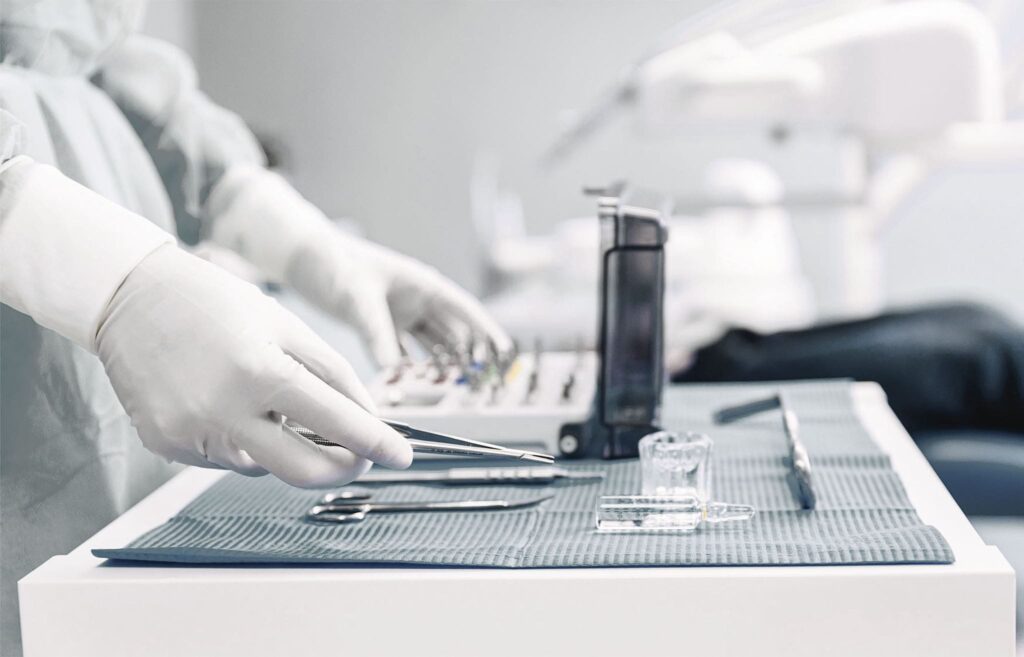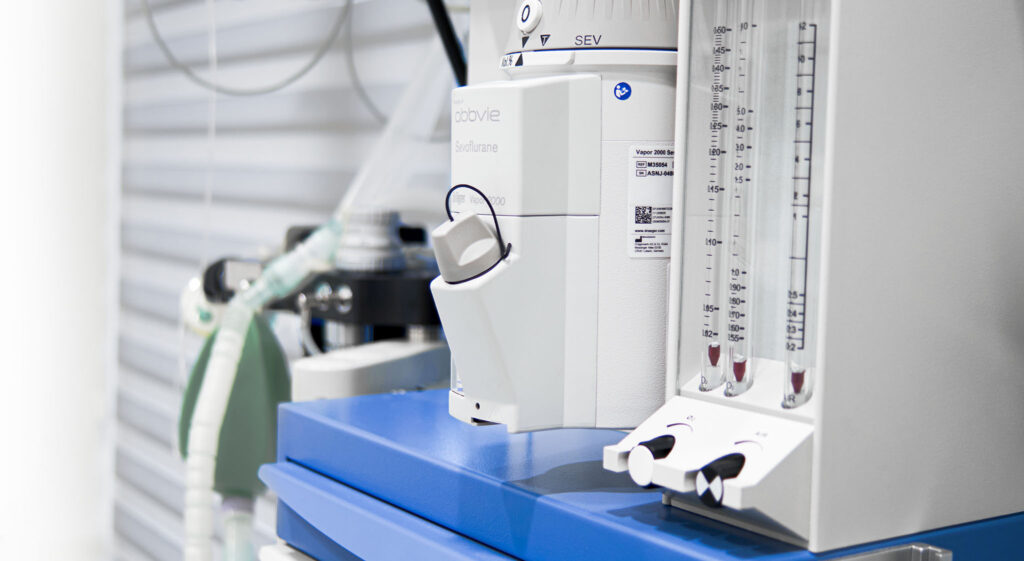
Oral Surgery
Oral surgery is a speciality of dentistry that focuses on the treatment of complex illnesses of the mouth and jaw. Tooth extraction is the most common oral surgical treatment performed on dental patients. Oral surgery, on the other hand, encompasses a wide range of procedures such as tumour removal, periodontal inflammation therapy, dental bone grafting, jaw plastic surgery, and many others.
Oral surgical procedures
Dental surgeons are specialists in diagnosing and treating diseases of the teeth, sinuses, jaws, temporomandibular joints, soft tissues, and oral mucosa. Our qualified oral surgeons’ main goals are to treat dental diseases while preserving as much natural tissue as possible inside the patient’s mouth and oral cavity.
Tooth extraction
The most common procedure in oral surgery is tooth extraction. Only when there is no other option for saving and preserving a tooth is it extracted
To avoid serious complications of infection, such as the appearance of abscesses and cysts, which can cause damage to adjacent teeth, it is necessary to remove an irreversibly damaged tooth. Molars and wisdom teeth that are impacted (unable to break through) are also frequently removed to either ensure proper dental occlusion or before orthodontic treatment.
In contemporary oral surgery, a variety of tooth extraction techniques are being used. The placement of the tooth, the complexity of the operation, potential complications, and a range of additional factors, all influence which method is most effective. Atraumatic tooth extraction is just one of the many methods that are being used to preserve as much tissue as possible around the removed tooth in order to ensure successful prosthetic implanting in the future.
Anaesthesia can be used to assist with the tooth extraction process, making the procedure completely painless. Our clinic uses cutting-edge technology to ensure high accuracy and safety during the procedure, as well as a quick recovery.
Dental abscess drainage (incision and drainage)
A dental abscess is an acute infectious inflammation that occurs near the tooth’s root or in the periodontal pockets (gums). Deep cavities, which allow bacteria to enter the inside of the tooth (pulp), are the most common cause of dental abscesses. An untreated dental abscess poses a significant threat to nearby teeth, soft tissue, and even the entire body. As a necessary consequence, if you develop symptoms of a dental abscess, it’s critical that you see a dentist as soon as possible.
An oral surgeon will perform an incision and drainage procedure to extract a complicated dental abscess. The abscess is first opened and disinfected, a latex drain is then inserted into the abscess cavity, as well as any abscesses that accumulate at the site of inflammation. The drain is removed and the surgical cut is sutured once the inflammation has subsided. Endodontic treatment of the root canal is also necessary if the abscess was caused by damage to the pulp of the tooth. Finally, the tooth is sealed and the surface is restored.
Cyst removal
Poor oral hygiene, failed endodontic treatment, root canal injuries, cavities, and other types of damage to the teeth and periodontium can cause dental cysts in the bones or soft tissues of the jaw. The surrounding tissues are damaged as the oral cyst grows, resulting in swelling, pain, and discomfort in the jaw area. Oral cysts can be surgically removed. Resection of the tooth’s root may be necessary if the cyst is growing at the apex of the tooth and endodontic treatment is ineffective. Resection is a dental surgery wherein the cyst, as well as parts of the tooth’s root, are removed.
Tooth root amputation (hemisection)
Hemisection is the surgical removal of one of a molar tooth’s roots (or a portion of the root). When an infection has severely damaged the root and therapeutic treatment is insufficient to resolve the problem, this dental surgery is performed.
Tooth root amputation can be done in two ways:
- External. The oral surgeon removes the damaged root by opening the mucosal lining above it. After that, a special osteoplastic material is used to fill the root’s former location, promoting bone regeneration. The doctor then returns the oral mucosa to its original location and sutures the incision site.
- Direct. The surgeon drills a hole in the tooth crown to allow access to the tooth’s roots. The tooth is then sealed and restored to its original shape after the damaged root is removed.
Treatment of alveolitis
To prevent bacteria from entering the alveoli (the holes in the roots of the removed tooth), a blood clot must form at the site of the surgery after the tooth extraction procedure. A clot may not form or fall out in some cases, and an infection in the wound can lead to alveolitis.
Alveolitis is a painful inflammation of the alveoli that can occur after a tooth has been extracted. Alveolitis is usually accompanied by general weakness, fever, headache, enlargement of the submandibular lymph nodes, and bad breath.
An oral surgeon will treat alveolitis. In most cases, simple cleaning and disinfection of the alveoli, as well as the artificial formation of a blood clot, is often all that is required. Special dental bandages can be applied to help treat more severe cases but this treatment may necessitate multiple visits to the oral surgeon.
Surgical exposure of impacted teeth
The surgical procedure of exposing an impacted tooth aims to restore the placement of a tooth that has been unable to break through the gum. An incision is made in the mucosa covering the affected tooth, exposing the crown. The wound is disinfected, and special steps are taken to ensure that it heals quickly. After 2-3 days, a brace is placed on the crown of the tooth and attached to the main orthodontic arch. The tooth extraction procedure then begins. A brace can sometimes be placed on the exposed tooth immediately after surgery. The canine teeth are the most frequently subjected to impaction.
Surgical crown lengthening
Dental crown lengthening is a surgical procedure that is done prior to prosthetic dentistry procedures or for cosmetic reasons.
- When the teeth appear small due to the large volume of the gums and cosmetic discomfort is felt, this operation can be performed for aesthetic reasons. In this case, the oral surgeon exposes a portion of the soft tissue around the tooth and creates a new gum contour artificially.
- If the supporting bone tissue or the surrounding gums are damaged, dental crown lengthening may be required before a tooth prosthesis can be installed. The oral surgeon ensures reliable prosthesis fixation and its long-term service by performing this procedure.
Vestibuloplasty
The front part of the mouth, which includes the lips, gums, and muscles that connect them, is known as the vestibule. Vestibule pathologies can cause cosmetic and speech defects. Surgical vestibule procedures are used to treat both clinical and cosmetic problems.
Before implants or other types of prostheses can be installed, vestibuloplasty surgery is typically required. In this case, the procedure is being used to create stable gums around the future prosthesis.
Gum recession treatment
Gum recession is when the amount of gum tissue in the mouth decreases. This can expose the roots of the teeth, allowing tartar to accumulate near them potentially resulting in further damage. Recession is a visible cosmetic flaw that can lead to serious dental issues and even tooth loss. Gum recession disease can be avoided with good oral hygiene and regular dental visits.
Gum recession can be treated with a variety of modern techniques. The dentist determines the most appropriate method based on the condition of the gums and the diagnosis. Surgical treatment is often used in severe cases of advanced recession. Using the adjacent and healthy parts of the patient’s mucosa, plastic surgery can help to cover the recession damage, remove calculus, and increase the volume of soft tissue. The procedure to cover the gum recession is carried out under local anaesthesia, so it is completely painless.
Gum flap surgery
During periodontitis, ‘periodontal pockets’ form, in which pathogenic bacteria start to develop. These bacteria have the potential to cause serious damage to the teeth’s roots. Late detection of this condition can result in generalised periodontitis (periodontal inflammation), which can lead to serious dental complications. A periodontist uses a professional clinical examination to determine the most effective treatment method for periodontitis. Treatment of periodontitis usually begins with conservative methods – professional oral hygiene, deep cleaning of the gingival pockets and supplementary care.
Gum flap surgery, the most effective surgical method of treating periodontitis, is used when conservative treatment fails. During the surgery, the oral surgeon reveals a layer of gums and manually cleans the inflamed periodontal pockets, removing the damaged tissues and disinfecting the area. Special techniques can be used to replace the missing dental supporting bone.
Tongue and lips tie surgery
Defects in the tongue and lips are diagnosed most commonly in children:
- The tongue frenulum is a small thin ligament that connects the tongue to the lower jaw. When it is not connected properly in childhood, it can cause problems chewing food and pronouncing sounds.
- The upper lip frenulum connects the upper lip to the anterior interdental space. When the milk front teeth begin to germinate, a defect can develop, and the improper anatomy can result in the formation of a large gap in the front teeth.
The tongue and upper lip defects are surgically repaired. A quick and painless procedure is performed to help alleviate potential future discomfort. It can be done under various types of anaesthesia, and the recovery time is usually only a few days.
When is surgical treatment required?
Dental diseases vary by stage of development, each of which is subject to a particular method of treatment. All oral issues are initially treated conservatively, with minimally invasive procedures. A high-quality dental treatment’s main goal is to save as many teeth (and the surrounding tissues) as possible.
In some cases, however, when the disease is complicated or non-invasive therapy is ineffective, conservative treatment makes room for surgery. Traumas, neoplasms, complex congenital pathologies, and inflammatory processes may all necessitate dental surgery.
It’s worth noting that maintaining oral health is far easier than restoring it after a long and arduous battle with dental disease. As a result, maintaining proper oral hygiene and visiting the dentist on a regular basis, has always been and will continue to be the best way to avoid surgical treatment.
Anaesthesia during surgery

Modern dental surgery’s primary goal is to achieve high clinical efficacy while maintaining patient safety and comfort. Therefore, the use of pain relief is very important. The most appropriate method of pain relief is chosen based on the patient’s age, psycho-emotional state, the complexity and extent of the procedure:
- Local anaesthesia – the most common type of anaesthesia used in dentistry, which only numbs a certain area of the mouth.
- Sedation – bringing the patient into a state of relaxation similar to shallow sleep. During sedation, consciousness is suppressed, while the ability to understand the doctor and respond to his words is maintained.
- General anaesthesia – a drug-controlled state of deep sleep. During general anaesthesia, an anesthesiologist is involved in the operation to ensure the safety of the patient. This method of anaesthesia is used for only the most difficult of surgical operations.
Postoperative period
Postoperative period
The patient is always given medical advice for postoperative rehabilitation after the surgical procedure. It is critical to follow them carefully in order to ensure a smooth healing process and avoid complications. The following are some general postoperative guidelines:
- Limiting stress and fatigue by reducing physical activity. Getting more rest and sleep.
- Dietary restrictions should be followed (excluding foods and beverages that are too hot, cold, sour, spicy, sweet, or viscous).
- Quitting smoking and drinking alcohol for the time being.
- Following oral hygiene guidelines to the letter.
Adherence to these guidelines is usually not difficult, but it does necessitate some self-control. The patient’s mindset and ability to stay organised can determine the length of postoperative regeneration.
Oral surgery in our clinic
Any high-performing dentist understands the importance of preserving and strengthening their patients’ teeth. As a result, the professionals who work in our clinics are always striving for the highest standards. This allows us to safely and effectively maintain and restore our patients’ oral health.
Our clinic’s experienced dentist surgeons are trained to use the most up-to-date methods for diagnosing, preventing, and surgically treating dental and oral diseases, injuries, and pathologies.
You can expect attentive service and the most effective treatment plan when you entrust your treatment to our oral surgery specialists. Surgical procedures are carried out in our clinics in a timely, safe, and painless manner. Moreover, each stage of treatment is accompanied by careful professional consultation.
Pricelist
Suaugusiųjų
| Tooth extraction | 100 € |
| Tooth extraction with general anaesthesia | 150-180 € |
| Complicated tooth extraction | 120 € |
| Complicated tooth extraction with general anaesthesia | 180-240 € |
| Wisdom tooth extraction | 120 € |
| Complicated surgical tooth extraction | 180-240 € |
| Removal of an excess tooth | 180-240 € |
| Incision, drain insertion | 80 € |
| Odontogenic cyst removal | 220 € |
| Tooth root tip resection | 320 € |
| Hemisection, amputation | 100 € |
| Treatment of alveolitis | 80 € |
| Surgical exposure of impacted tooth for orthodontic purposes | 180 € |
| Clinical extension of tooth crown | 220 € |
| Vestibuloplasty in one quarter (price without materials) | 240 € |
| Recession coverage (1 tooth) | 250 € |
| Gum flap surgery | 150 € |
Vaikų
| Milk tooth extraction | 65 € |
| Milk tooth extraction with sedation | 85–95 € |
| Milk tooth extraction with general anaesthesia | 80 € |
| Tongue/lips tie surgery | 120–240 € |










